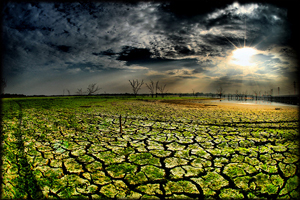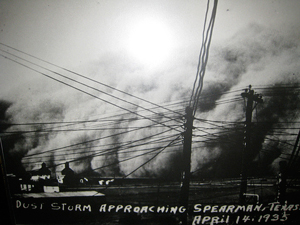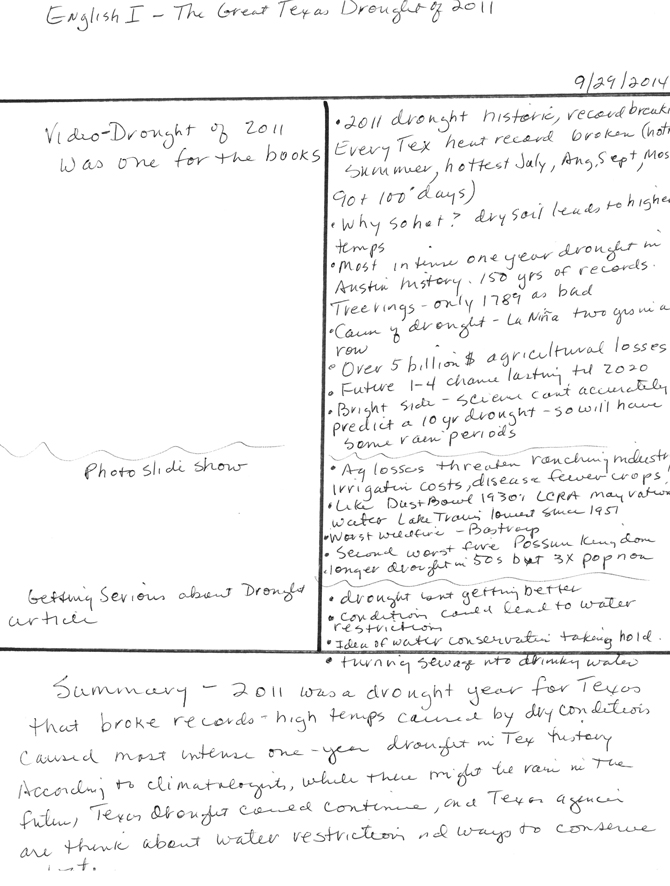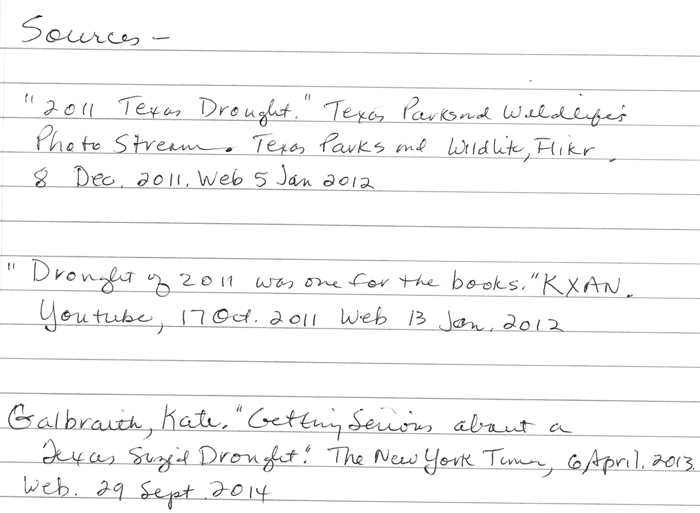
Source: Cracked Lake, crowt59, Flickr
Let’s begin by finding out what you know and what you don’t know about the expository essay topic “The Great Texas Drought of 2011.” Several strategies can help you to figure out this information. The first strategy you will learn about is note-taking, something you have probably done in your classes. However, the Cornell system of note-taking, which you will learn, is a popular and effective note-taking method that may be new or different from your past experiences. This strategy isn’t the only way to take notes, but in this lesson, it’s the one we will use.
No matter what method you use to take notes, you need evidence from magazine or newspaper articles, reference books, websites, or other reliable sources. You might also choose to include personal anecdotes or conversations and interviews that you conducted with weather experts or people who experienced “The Great Texas Drought of 2011” firsthand.
Cornell Notes
To use the Cornell method of taking notes, you need to set up your notebook. You can use individual sheets of paper, but when possible, use a notebook. It will keep your notes together and in order. To begin setting up your notebook, follow these steps:
- If your notebook paper doesn’t include a line at the top, draw one as shown in the example below.
- Draw a dark horizontal line about six lines or two inches from the bottom of the page.
- Draw a dark vertical line about three inches from the left side of your notebook paper. Start at the top and stop at the bottom horizontal line you drew in the previous step.
- Write the name of the course, the title of the assignment, and the date on the top line of the page.
Note: We have created space for three main ideas in the example below, but you may have more or fewer for different topics.
|
||||||||||
It will also be helpful to keep these guidelines in mind:
- Use the column on the left to write main ideas.
- Use the column on the right to write notes.
- Skip a line between ideas and topics so they don’t get mixed up.
- Try not to use complete sentences; they take up a lot of space.
- Write a brief summary of the main ideas in the bottom section.
- Once you’re finished taking notes about the source material, check that what you have written makes sense to you.
Let’s look at an example of how to use Cornell note-taking for writing an expository essay with the topic “The Great Texas Drought of 2011.” Click the link to download the Cornell Notes template. Keep it open to take notes on the three sources you are about to read. Pretend that you found these sources while conducting preliminary research on your topic: a news video, a photographic slide show, and a newspaper article.
Source 1
Watch this video segment about the drought from the previous lesson called “Generate Ideas and Questions.” For this first source, we listed the main ideas for you, but feel free to use the Cornell Notes handout to take notes about supporting details or other ideas that interest you in this video.
Source: “Drought of 2011 was one for the books,” KXAN, YouTube

Source: Dust Bowl 1935, MyEyeSees, Flickr
The main ideas from the video segment are as follows:
- 2011 drought may become long-term
- History-making drought that people will remember for a long time
- Every major Texas heat record was broken (including hottest summer ever, hottest month ever, hottest August temperature, most 90- and 100-degree days).
- Cause of heat: Dry soil leads to higher temperatures
- Cause of drought: Two years of La Niña
- In 150 years of record-keeping, Austin has never had a drier year.
- Texas Agriculture: worst losses in history, totaling five billion
- Climatologist: drought could last until 2020, similar to 1950s drought.
- Other scientists suggest that we can’t accurately predict a long-term drought and can expect rainy periods within a long drought.
Source 2
Take a look at the photographic montage about the drought. When you’re finished, use the Cornell Notes handout to write down the main ideas, supporting details, and anything else you found interesting.
Source: Texas Parks and Wildlife, Texas Parks and Wildlife’s Photostream, Flickr.
Source 3
Finally, read this newspaper article about the drought. When you’re finished, use the Cornell Notes handout to write down the main ideas, supporting details, and anything else you found interesting.
AUSTIN, Tex.
SOMETHING odd happened here last week.
It rained.
But the relief, an answer to desperate prayers, is likely to be short-lived. The drought that has gripped much of Texas since the fall of 2010 shows few signs of abating soon. The latest forecasts say that parched West and South Texas will remain dry, and that the state is likely to see above-average temperatures this spring, increasing evaporation from already strained reservoirs. The conditions could lead to severe water restrictions in some parts of the state.
The implications have finally sunk in among lawmakers and business leaders here, who like to boast about the economic appeal of Texas’s low taxes and relaxed regulatory environment: no water equals no business. In a state fabled for its everything-is-bigger mentality, the idea of conserving resources is beginning to take hold. They are even turning sewage into drinking water.
Now that you have read and created notes for all three sources using the Cornell Notes handout, click the Check Your Understanding link below to see how another student used Cornell Notes to collect information from the three sources.

When you find sources you plan to use in your essay, don’t forget to write down the authors, titles, locations, website addresses, journal names, dates published and any other important bibliographic information.This documentation will be important for locating the sources later and for listing them in the bibliography or references section of your essay.
For example, we wrote the information about the three sources above on the back of our notes so that this documentation wasn’t lost. To see the kinds of information we collected, review the sources below:

Source: Resources list, IPSI